Vehicle Weight Regulations
A vehicle’s maximum allowable weight depends upon the number and spacing of its axles and the number and size of its tires. An online legal weight calculator at https://sdaps.sd.gov/sdaps can help operators determine the maximum legal weight for specific configurations.
Tire Limitations
The weight supported on a tire may not exceed 600 pounds per inch width of the tire if the tire is:
- mounted on a steering axle;
- mounted on an axle equipped with dual tires;
- mounted on a trailer towed by a vehicle with a GVWR of 11,000 pounds or less; or
- a wide-base super-single tire at least 445 millimeters (17.5 inches) wide operated on a highway listed in Table 8.
Table 8: Highways Allowing 600 Pounds per Inch of Tire Width for Wide-Base Super-Single Tires
| Highway |
|---|
| US12 from Interstate 29 to Aberdeen |
| SD37 from Interstate 90 to Huron |
| US83 from Interstate 90 to Pierre |
| SD79 from Interstate 90 to the Nebraska border |
| US85 from Interstate 90 to Belle Fourche |
| SD50 from Interstate 29 to Yankton |
| The Interstate highway system: I-29, I-90, I-229 |
| Any locally designated highway within the corporate limits of any municipality adjacent to the interstate highway system |
The weight supported by tires mounted on any other axle may not exceed 500 pounds per inch width of tire. Table 9 shows the weight allowed for various tire sizes.
Table 9: Allowable Weight (in pounds) by Tire Size
| Manufacturer’s Tire Size | Inch Width | 500 lb/inch | 600 lb/inch |
|---|---|---|---|
| 8.00 inches | 8.00 inches | 4000 | 4800 |
| 8.25 inches | 8.25 inches | 4125 | 4950 |
| 215 millimeters | 8.47 inches | 4235 | 5082 |
| 8.75 inches | 8.75 inches | 4375 | 5250 |
| 225 millimeters | 8.86 inches | 4430 | 5316 |
| 9.00 inches | 9.00 inches | 4500 | 5400 |
| 235 millimeters | 9.25 inches | 4625 | 5550 |
| 238 millimeters | 9.37 inches | 4685 | 5622 |
| 9.50 inches | 9.50 inches | 4750 | 5700 |
| 245 millimeters | 9.64 inches | 4820 | 5784 |
| 10.00 inches | 10.00 inches | 5000 | 6000 |
| 255 millimeters | 10.04 inches | 5020 | 6024 |
| 265 millimeters | 10.43 inches | 5215 | 6258 |
| 275 millimeters | 10.83 inches | 5415 | 6498 |
| 11.00 inches | 11.00 inches | 5500 | 6600 |
| 285 millimeters | 11.22 inches | 5610 | 6732 |
| 295 millimeters | 11.62 inches | 5810 | 6972 |
| 12.00 inches | 12.00 inches | 6000 | 7200 |
| 315 millimeters | 12.40 inches | 6200 | 7440 |
| 365 millimeters | 14.37 inches | 7185 | 8622 |
| 385 millimeters | 15.16 inches | 7580 | 9096 |
| 425 millimeters | 16.73 inches | 8365 | 10,038 |
| 445 millimeters | 17.52 inches | 8760 | 10,512 |
| 455 millimeters | 17.91 inches | 8955 | 10,746 |
| 18.00 inches | 18.00 inches | 9000 | 10,800 |
Axle Group Limitations
The maximum allowable weight for all individual axles and axle groups is limited by statute (Table 10).
Table 10: Axle Group Weight Limits
| Group Type | Maximum Allowable Weight |
|---|---|
| Single Axles | 20,000 pounds |
| Tandem Axles | 34,000 pounds |
| Other Axle Groups | based upon the Bridge Weight Formula |
Bridge Weight Formula
The maximum weight on any group of consecutive axles is limited by the Bridge Weight Formula:
W = 500[(LxN)÷(N-1)+12N+36]
Where:
- W = Maximum Weight, rounded to the nearest 500 pounds
- L = Distance in feet between the extreme axles of a group (this distance is called the “bridge” distance)
- N = Number of axles in a group
Bridge Weight Formula Table
The Bridge Weight Formula Table (Table 11) shows the maximum allowable weight for various axle groupings and spacings. To use the table, round axle spacings to the nearest whole foot (for example, round 15’-5” to 15’, 15’6” to 16’).
Legal Weight Calculation Examples
Table 12 shows the allowable legal weight for several common truck configurations. The tire size, number of axles, and axle spacing all affect the allowable legal weight. Smaller tire sizes, fewer axles, and closer axle spacing reduce the legal weight. Table 13 and Table 14 illustrate how to calculate legal weights for any truck configuration. The worksheet of Table 15 can be used to calculate the legal load of truck with up to seven axles. An online interactive legal weight calculator at https://sdaps.sd.gov/sdaps can help operators determine the maximum allowable weight for any specific truck configurations.
Table 12: Legal Weight Examples
| Vehicle Description | Allowable Weights |
|---|---|
| Single Unit, 2-axle Truck |  |
| Single Unit, Tandem Axle Truck | 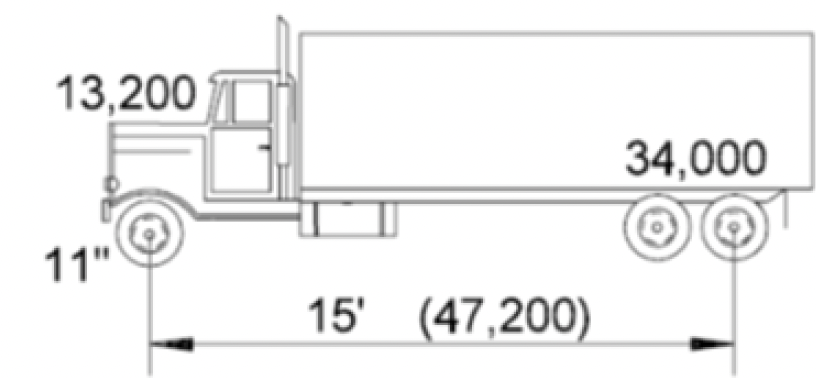 |
| Single Unit, Tridem Axle Truck | 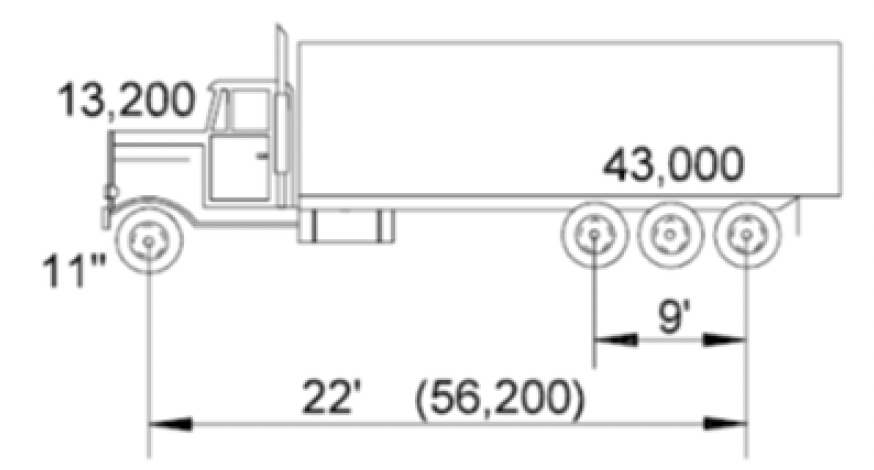 |
| 4-axle Tractor-Semitrailer | 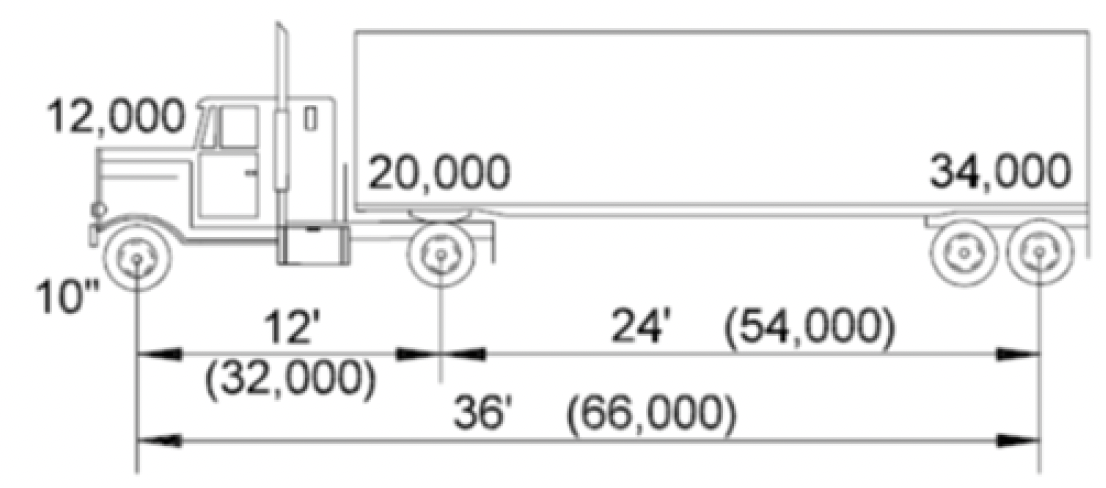 |
| 5-axle Tractor-Semitrailer | 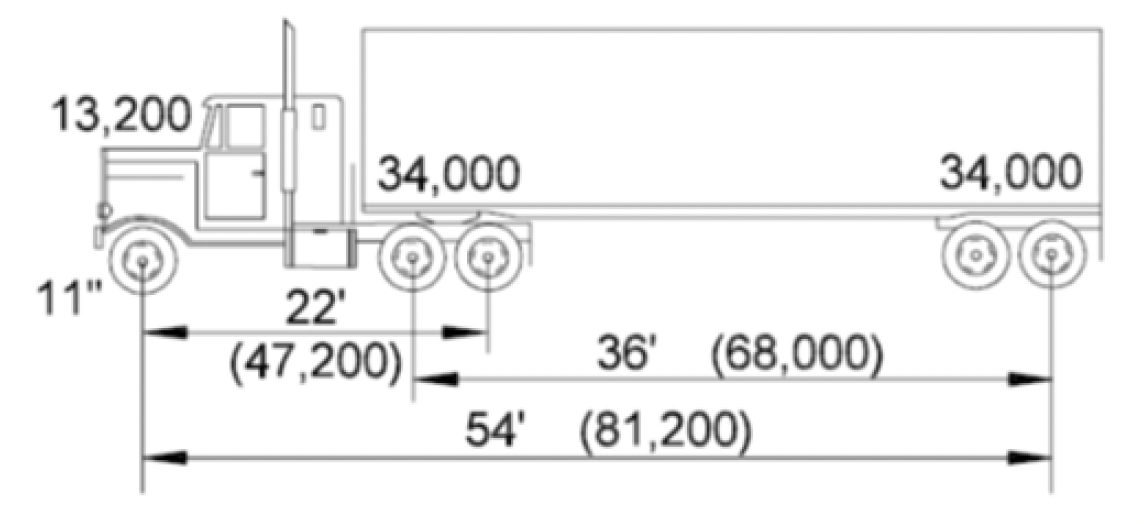 |
| 6-axle Tractor-Semitrailer | 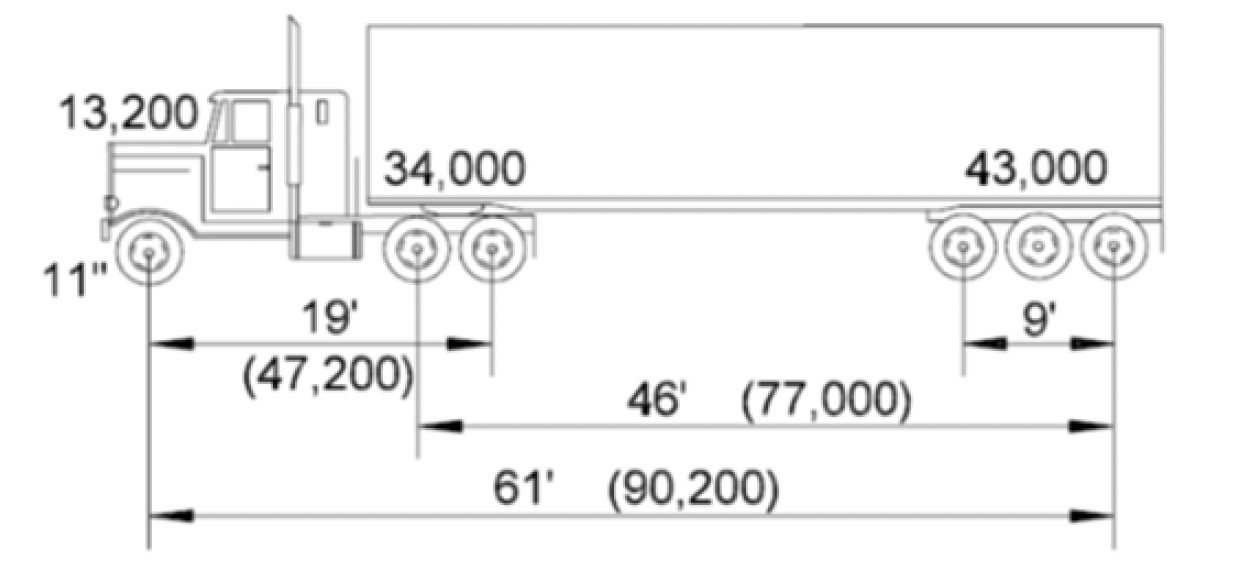 |
| 7-axle Tractor-Semitrailer | 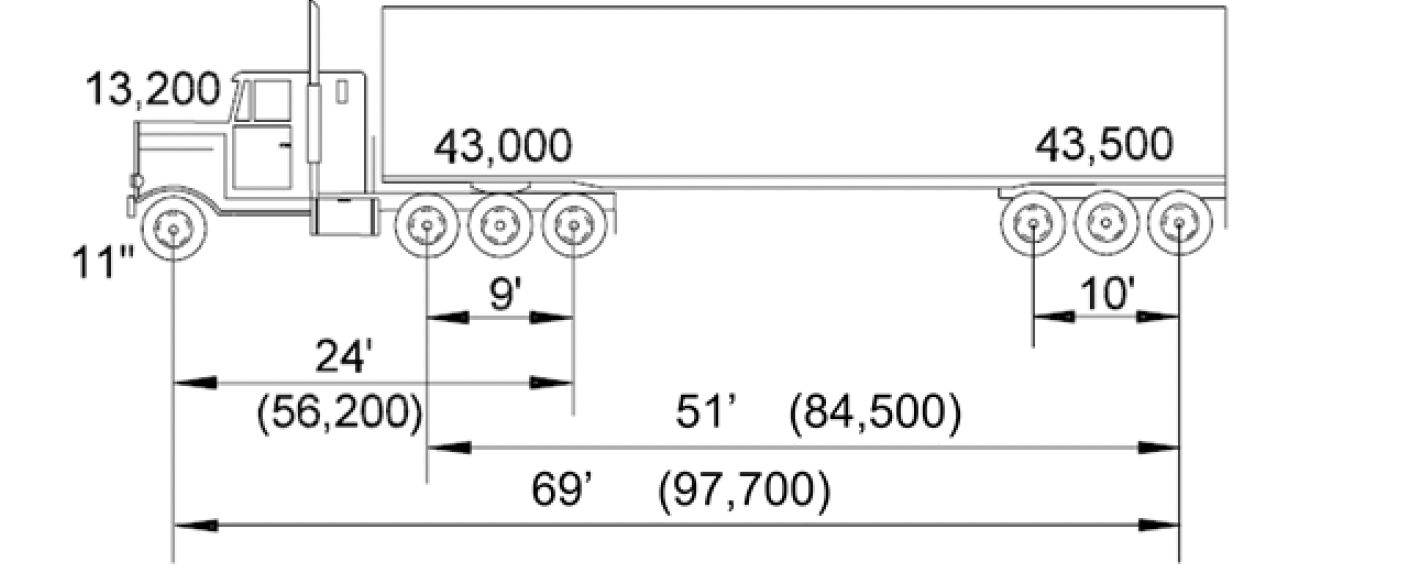 |
| Tractor-Semitrailer-Trailer Combination | 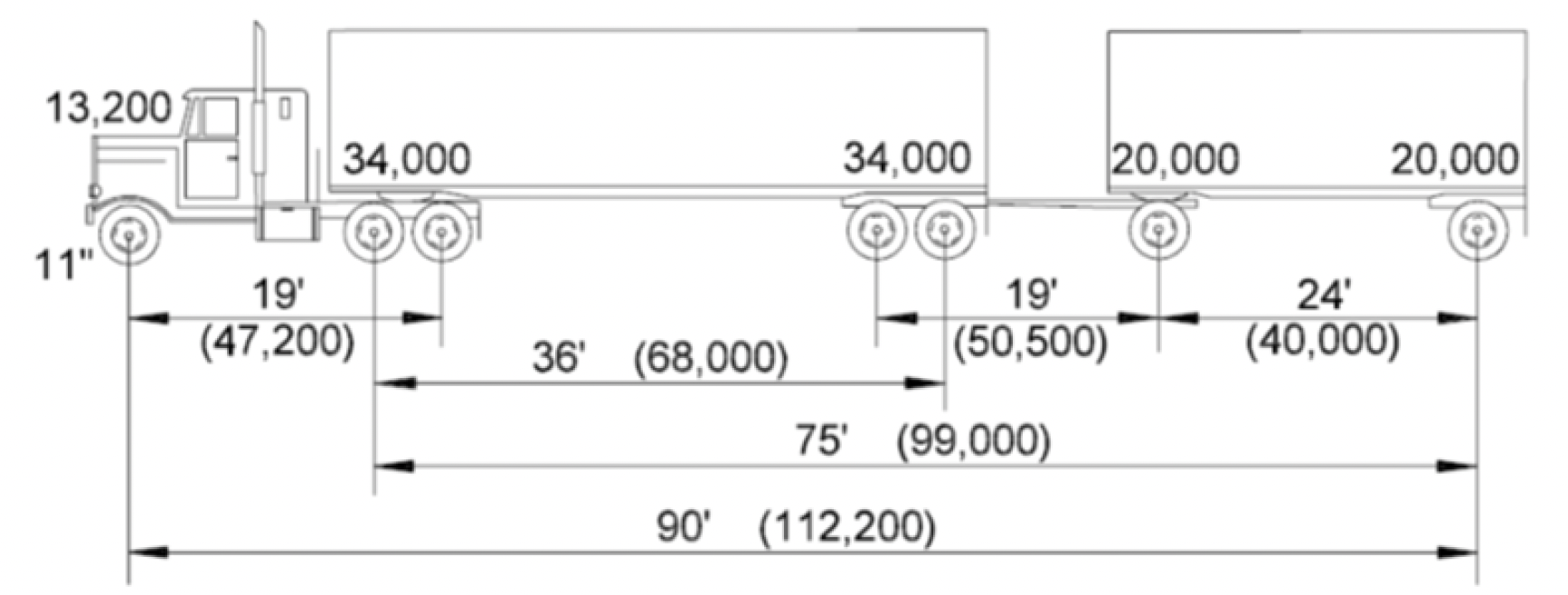 |
Table 13: Legal Weight Calculation Example 1

| Axle No | 1 | 2 | 3 | 4 | 5 | 6 | 7 |
| Axle Spacing | 16′ | 0″, 4′ | 6″, 4′ | 6″, 32′ | 0″, 4′ | 6′, 4′ | 6″ |
| Tires | 2@11:00 | 2@11:00 | 4@11:00 | 4@11:00 | 2@12:00 | 2@12:00 | 2@12:00 |
| Maximum Axle Weight* | |||||||
| Group Description: | |||||||
| 4 axles in 25’ | 56,200 | ——– | ——– | ——– | |||
| 7 axles in 96’ | 92,200*** | ——– | ——– | ——– | ——– | ——– | ——– |
| 2 axles in 5’ | 31,000** | ——– | |||||
| 3 axles in 9’ | 43,000 | ——– | ——– | ||||
| 6 axles in 50’ | 79,900 | ——– | ——– | ——– | ——– | ——– | |
| 2 axles in 5’ | 34,000** | ——– | |||||
| 2 axles in 5’ | 24,000** | ——– | ——– | ||||
| 3 axles in 9’ | 36,000 | ——– | ——– | ||||
| 2 axles in 5’ | 24,000** | ——– |
* Maximum weight on a single axle is limited to 20,000 pounds or the allowed weight per inch width per tire as defined in statute. In this configuration, the steering axle and axles equipped with dual tires are limited to 600 pounds per inch width of tire, while the remaining tires on axles 2, 5, 6, and 7 are limited to 500 pounds per inch width of tire.
** Maximum weight on a two-axle group with axles spaced 96 inches or less apart is 34,000 pounds. Axles spaced 40 inches or less apart are considered a single axle.
*** The maximum gross vehicle weight on Interstate Highways is limited to 80,000 pounds unless an annual Over 80,000 Pounds on Interstate Permit (Chapter 6, Permits) has been issued to the vehicle. The Gross Vehicle Weight of this configuration is limited to 92,200 pounds.
Table 14: Legal Weight Calculation Example 2

| Axle No | 1 | 2 | 3 | 4 | 5 | 6 | 7 |
| Axle Spacing | 15′ | 0″, 4′ | 6″, 27′ | 0″, 4′ | 2″, 16′ | 0′, 24′ | 0″ |
| Tires | 2@12.00 | 4@11.00 | 4@11.00 | 4@11.00 | 4@11.00 | 4@11.00 | 4@11.00 |
| Maximum Axle Weight* | 14,400 | 20,000 | 20,000 | 20,000 | 20,000 | 20,000 | 20,000 |
| Group Description: | |||||||
| 3 axles in 20’ | 48,400 | ——– | ——– | ||||
| 5 axles in 51’ | 80,000 | ——– | ——– | ——– | ——– | ||
| 6 axles in 67’ | 94,000 | ——– | ——– | ——– | ——– | ——– | |
| 7 axles in 91’ | 113,000**** | ——– | ——– | ——– | ——– | ——– | ——– |
| 2 axles in 5’ | 34,000** | ——– | |||||
| 4 axles in 36’ | 68,000*** | ——– | ——– | ——– | |||
| 5 axles in 52’ | 80,500 | ——– | ——– | ——– | ——– | ||
| 6 axles in 76’ | 99,500 | ——– | ——– | ——– | ——– | ——– | |
| 2 axles in 4’ | 34,000** | ——– | |||||
| 3 axles in 20’ | 51,000 | ——– | ——– | ||||
| 4 axles in 44’ | 71,500 | ——– | ——– | ——– | |||
| 2 axles in 24’ | 40,000 | ——– |
* Maximum weight on a single axle is limited to 20,000 pounds or the allowed weight per inchwidth per tire as defined in statute.
** Maximum weight on a two-axle group with axles spaced 96 inches or less apart is 34,000 pounds. Axles spaced 40 inches or less apart are considered a single axle.
*** Two consecutive sets of tandems may carry a gross load of 68,000 pounds (34,000 per tandem) provided the overall distance between the first and last axles of such consecutive sets of tandems is 36 feet or more.
**** The maximum gross vehicle weight on Interstate Highways is limited to 80,000 pounds unless an annual Over 80,000 Pounds on Interstate Permit (Chapter 6, Permits) has been issued to the vehicle. The Gross Vehicle Weight of this configuration is limited to 113,000 pounds.
Tolerances and Penalties
Tolerance for Hauling from Point of Harvest
Vehicles hauling agricultural products from a harvesting combine to the point of first unloading are granted a tolerance of 10 percent more than the legal limits if operating within a range of 50 miles of the harvested field. The fine or penalty applies only to that portion of the load more than 10 percent above the legal limit. This tolerance is not permitted on the Interstate Highway System.
Tolerance for Hauling from a Farm
Vehicles hauling agricultural products from farm storage or livestock from a farm are given a tolerance of 5 percent more than the legal limits if operating within a range of 50 miles of the loading site. Such vehicles may not exceed any posted weight of any bridge or road. This tolerance does not apply during spring load restrictions and is not permitted on the Interstate Highway System. The fine or penalty applies to the portion of the load more than five percent above the legal limit.
Overweight Penalties
A vehicle that is overweight on a tire, wheel, axle, or axle group is not allowed to proceed until it is made legal by either shifting the load or unloading part of the load. An overweight violation is a Class 2 misdemeanor punishable by up to a $500 fine or 30 days in jail, or both. In addition, a civil penalty in the following amount is charged:
Table 16: Overweight Penalty Schedule
| Pounds Overweight | Civil Penalty |
|---|---|
| 1,001 pounds to 3,000 pounds | 5 cents/pound |
| 3,001 pounds to 4,000 pounds | 15 cents/pound |
| 4,001 pounds to 5,000 pounds | 22.5 cents/pound |
| 5,001 pounds to 10,000 pounds | 37.5 cents/pound |
| Over 10,000 pounds | 75 cents/pound |
The civil penalty is assessed at a single rate according to the cents per pound penalty for the highest weight violation. For example, the penalty for a vehicle 4,200 pounds overweight is $0.225 X 4200 = $945.00.
